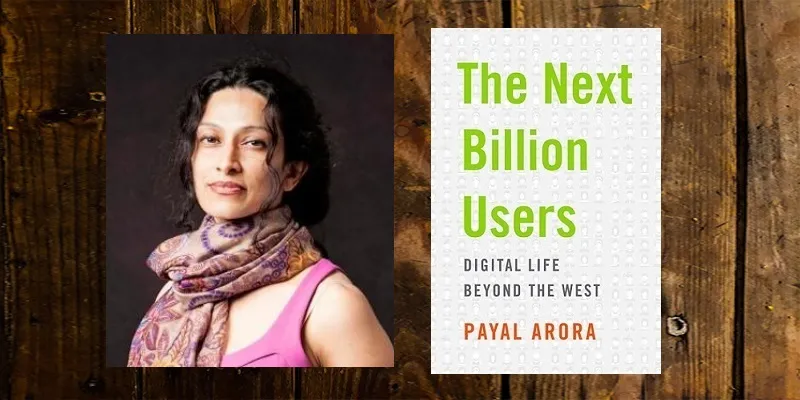Why digital benefits need to be balanced with data privacy - Payal Arora, author, ‘The Next Billion Users’
It is important to understand the exciting opportunities unleashed by digital media, but countries like India should also protect their data. This research scholar shares insights on emerging issues at the cutting edge of the digital frontier.
Digital anthropologist Payal Arora is the author of The Next Billion Users: Digital Life beyond the West (see my book review here). She grew up in Bengaluru and graduated from Harvard and Columbia. She is an Associate Professor in the School of History, Culture, and Communication at Erasmus University, Rotterdam.

Her book presents research on the online lives of poor people in emerging economies, and shows that they use online media not just to study, find jobs, and obtain health information, but also seek pleasure, visibility, leisure, and entertainment. In the process, they negotiate issues of privacy, interaction, and social tradition.
In a chat with YourStory, Payal talks about policy implications of digital media, data security, her research collaborations, new insights on how the poor are using online media, and her next book on ‘AI for Good.’
Edited excerpts from the interview:
YourStory (YS): What is your current field of research in digital media? What is your next book going to be about?
Payal Arora (PA): I am currently working on a book on ‘AI for Good’ (Artificial Intelligence for doing good) as I would like to unpack what ‘good’ means when it comes to harnessing AI. We seem to be now putting a lot of faith in AI worldwide.
There is much momentum in this area, so it’s time to get critical so that we can manage expectations and steer tech design towards more productive ends.
YS: What were some of the reactions to your book, 'The Next Billion Users'?
PA: The book has been received particularly well among tech entrepreneurs and telecom businesses in Latin America, Asia, and within Europe. Also, many tech policy and activist organisations are taking note to broaden their approach in traditional policies to bridge “digital divides.”
The book has also been reviewed positively by The Economist, The Nation, Strategy & Business, Engadget (my book was selected as one of “the most interesting, thought-provoking books on science and technology we can find” by Engadget), Top 5 in the ‘Technorati Top 100,’ and reported by Time for being one of the “best blogs” on tech.
What is particularly interesting is the focus on privacy and surveillance and how that is drawing in the tech crowd. The reactions are like a wake-up call on these new users and this is a great feeling to have especially as a digital anthropologist.
I feel like I am slowly moving towards bridging the industry and academia in a way that may make a difference, and this is across global contexts.
YS: In the time since your book was published, what are some notable new findings or examples you have come across of digital media usage by the poor?
PA: I found that low socio-economic classes in India (according to the KPMG 2018 report) consume more digital video content than any other demographic.
This is exciting as it validates my argument that they are so much more enthusiastic than any other segment of the society, as these new digital spaces are providing a kind of level-playing field for them, which clearly the conventional systems have failed to provide.
YS: What are your findings with respect to how diasporic communities are connecting to their home countries for tech-led initiatives?
PA: Diasporic communities, depending on their class and the reasons for migration, have different implications on this question. If they are forced migrants searching for jobs for survival, then a number of fintech initiatives have been liberating for them as it allows them to send remittances without the extortionist rates currently in place.
YS: You recommend the overhauling of business models of large media firms so that the poor get affordable access to content like movies and music. How can such business models be re-wired?
PA: Firstly, to stop the moral panic on piracy. Instead of just looking for punitive measures to this situation, let us capitalise on the economy of scale and diversify content.
Tell stories that are beyond the usual risk-averse formulas and try to understand what these new billion users want in terms of sustained engagement that make it worth their while to spend money on.
YS: What are some ways in which researchers are collaborating on understanding digital impacts?
PA: Currently, I am working with Rumman Chowdhury on cross-cultural feminist technologies and how this can address the growing misogyny online and the massive and growing gender divide in access and usage of tech.
We are working to bring together scholars, practitioners, and policymakers to think together on this subject for a special issue in Global Perspectives, a new journal by University of California Press.
YS: You rightly note that some jugaad innovations are unsafe and shoddy. What are some ways of improving their quality and lowering risk?
PA: The way to improve it is to institutionalise innovations with accountability mechanisms grounded in safety and security of citizens.
YS: From your journeys across India over the years, what are some challenges and opportunities that media researchers and activists seem to be missing?
PA: Genuine outreach with women at the margins of society and documenting their thoughts, their fears, and their hopes. It is hard to get women to talk about their concerns as they are afraid of disclosing personal issues due to major societal pressures in patriarchal communities.
YS: How can we focus more on teachers, instead of only on student-centric apps?
PA: We need to design applications that look at teachers not as obstacles to schooling but as an integral part of this process. We need to move the focus from autonomous applications to assistive applications and aid good teachers in the pipeline, in their curriculum design and to stay up to date with information
YS: We are now seeing concerns about data privacy escalating to higher levels with respect to companies like Facebook and TikTok. What are the optimum requirements for data protection regimes that can yield satisfactory levels of visibility v/s privacy?
PA: It is not sufficient for TikTok to say that it is working with the government by investing in digital infrastructure in India. This was what the British said about the railways during colonial times – and yes, the railways did help Indians massively move across the country, but what this also did was fundamentally aid the British in raping the resources of India systematically over centuries.
So likewise, when companies institute digital infrastructure, let’s not fall into that trap again. Indian data should be secured and should be protected, as clearly data is the future of this digital economy. India is in a different place now and should learn from its past.
YS: Overall, are you optimistic about the impact of digital technology in emerging economies, or are there serious cautions that need to be raised?
PA: Of course, I am very excited about these possibilities – and I tend to push this position even more so among circles in academia, policy making, and popular media, as the moral panic within these circles can be alarmingly high and misrepresent what actually goes on within these platforms based on some horror stories in the media.
We should be concerned about issues like privacy and data protection, but also give equal weight to why millions of young people are drawn to these technologies – not because they are mindless or superficial, but because they are an ambitious, hopeful, and fundamentally aspirational future generation.
(Edited by Megha Reddy)










